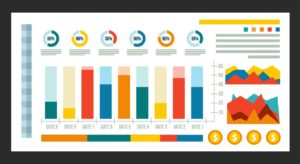Data Analytics
Descriptive Analytics: What happened or what is happening in the Business?
Being in any kind of a service sector, it is most important for the organizations to know “What is happening/happened in their business?” – this question can be answered by the historical data that has been collected and maintained in variety of data sources like Dataware house and various formats of files. BI technologies along with the fundamental knowledge of statistics and probability play a key role to summarize or visualize such historical data, through which we can understand the hidden facts that are underlying in data, and take informed decision to serve the customers better and to realize the growth in the business.

To perform Descriptive Analytics, considering the availability of huge volume of data the Business Analysts or Data Analysts usually relay on the Statistical software like R, SAS, and Python based statistics related packages, and Visualization (including dashboard presentation) software like Tableau, QlickSense, QlickView and other modern Bigdata software to mould the raw data to highly informative visuals and short summaries of data.
Predictive Analytics: What can happen in future?
To put it in simple terms Predictive Analytics is a way that helps you to predict or forecast “future” based on the historical data that comprises variety of variables/signals. Predictive Analytics works on a principle called “History repeats” in one way or other way. The predictive analytics techniques/algorithms when applied on historical data, they understand and capture the hidden patterns in the historical data, then generates the models that make the predictions on “future”.
As an example, being an international retail business brand, you can depend on the predictive analytics models to make daily/weekly/monthly predictions on what quantities of SKUs (stock keeping units) can be maintained as part of inventory. And, as a banker you can predict how much of loan can be approved for a given customer. Like this, almost every business on the glob can make use of predictive analytics to take better business decisions.

Cognitive Analytics
Cognitive Analytics aims at building a system that can mimic human brain. Such systems can be built with the amalgamation of modern Artificial Intelligence technologies like Machine Learning, Deep Leaning, Natural Language Processing, Speech Recognition etc. Building such “cognitive system” demands a huge amount of data-can be in unstructured, structured or semi-structured, and a careful architecture of efficient software pipelines.
A well-built cognitive system should be able to respond like a human being at a given context.
